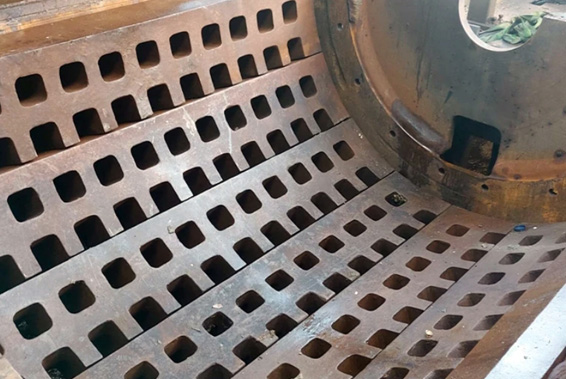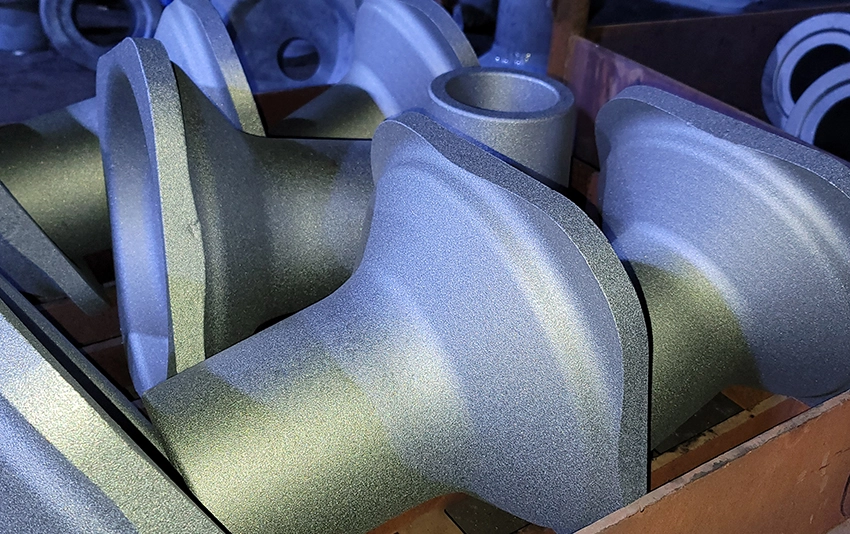ASTM A128 Grade B Manganese Steel Gratings for Precision Shredding
Overview of Austenitic Manganese Steel Gratings
Austenitic manganese steel gratings, manufactured to ASTM A128 Grade B standards, are essential components in shredder screens, designed to control the output size of shredded scrap by filtering processed materials. These gratings ensure consistent particle size, enhancing the efficiency of downstream recycling and material handling processes. WALKSON’s gratings, crafted from high-toughness austenitic manganese steel (similar to Mn13), offer exceptional wear resistance under impact, making them ideal for metal recycling, waste processing, and mining applications. Compatible with leading shredder brands like LINDEMANN, Metso, and others, our gratings are engineered for durability and precision in demanding shredder environments.
Material Benefits of ASTM A128 Grade B Gratings
Made from ASTM A128 Grade B austenitic manganese steel, WALKSON’s gratings combine high toughness with superior wear resistance. Key properties and benefits include:
· High Toughness: Withstands repeated high-impact forces without cracking, ensuring structural integrity in shredder screens.
· Wear Resistance Under Impact: The work-hardening properties of austenitic manganese steel increase surface hardness upon impact, extending service life in abrasive conditions.
· Corrosion Resistance: Performs reliably in harsh, corrosive environments common in recycling and waste processing.
· Cost Efficiency: Long-lasting gratings reduce replacement frequency, minimizing downtime and maintenance costs.
· Precision Sizing: Custom aperture designs ensure accurate control of shredded scrap output size.
These properties make WALKSON’s ASTM A128 Grade B gratings a top choice for shredder screen applications, delivering reliable performance in high-impact environments.
Compatibility with Leading Brands
WALKSON’s austenitic manganese steel gratings are precision-manufactured to meet OEM specifications, ensuring seamless integration with shredder screens from top manufacturers, including:
· LINDEMANN: Ideal for shredder gratings in metal recycling systems.
· Metso: Shredder and crusher screen assemblies.
· Eidal: Vertical and horizontal shredders.
· Hammermills, Sierra, and more: Custom gratings for specialized equipment.
Our team offers tailored solutions, designing gratings with specific aperture sizes and configurations to meet shredder requirements. Contact us at info@walkson.com (mailto:info@walkson.com) or via WhatsApp/WeChat to discuss LINDEMANN-compatible or custom grating designs for shredder screens.
Modern and Standardized Manufacturing Process
WALKSON employs a state-of-the-art manufacturing process to produce ASTM A128 Grade B austenitic manganese steel gratings, adhering to rigorous international standards for quality, precision, and consistency. The process is optimized to enhance toughness and wear resistance, and includes:
1. Raw Material Selection:
o High-purity ASTM A128 Grade B austenitic manganese steel is sourced from certified suppliers, compliant with ISO 9001 and ASTM standards.
o Chemical composition is verified to ensure optimal manganese and carbon content for work-hardening properties.
2. Melting and Casting:
o Melting is conducted in electric arc furnaces or induction furnaces to achieve uniform material properties.
o Sand casting or lost foam casting techniques are used, adhering to ISO 2642 for dimensional accuracy.
3. Heat Treatment:
o Gratings undergo specialized heat treatment, including austenitizing and water quenching, to optimize toughness and work-hardening capabilities.
o Processes comply with ASTM A128 standards for austenitic manganese steel castings.
4. Machining and Finishing:
o CNC machining centers and precision grinding equipment ensure accurate aperture sizes and surface quality.
o Tolerances are maintained per ISO 2768 for machining accuracy, critical for shredder screen performance.
5. Quality Assurance:
o Comprehensive inspections and testing verify compliance with client specifications and international standards.
International Standards Guiding Production
WALKSON’s manufacturing process is guided by globally recognized standards to ensure quality and reliability:
· ISO 9001:2015: Quality management system for consistent product performance.
· ASTM A128/A128M: Standard specification for austenitic manganese steel castings.
· ISO 2642: Dimensional tolerances for castings.
· ISO 8062: Casting tolerances and surface finish requirements.
· EN 10204: Material certification for traceability and compliance.
These standards ensure that every austenitic manganese steel grating delivers exceptional durability and performance, particularly for shredder screen applications.
Equipment Involved in Manufacturing
WALKSON’s advanced production facilities are equipped with cutting-edge technology to produce precision-engineered gratings:
· Electric Arc Furnaces: For high-purity melting of austenitic manganese steel.
· Induction Furnaces: For precise temperature control during melting.
· Heat Treatment Furnaces: For controlled austenitizing and quenching processes.
· CNC Machining Centers: For accurate aperture machining and finishing.
· Spectrometers: For chemical composition analysis.
· Coordinate Measuring Machines (CMM): For dimensional verification.
Rigorous Testing Protocols
WALKSON implements comprehensive testing procedures to ensure the quality and performance of ASTM A128 Grade B austenitic manganese steel gratings, verifying their toughness, wear resistance, and structural integrity. Tests comply with international standards and include:
1. Non-Destructive Testing (NDT):
o Ultrasonic Testing (UT): Detects internal defects, compliant with ASTM E709.
o Penetrant Testing (PT): Identifies surface cracks, per ASTM E165.
o Magnetic Particle Testing (MT): Ensures surface and near-surface integrity, per ASTM E1444.
2. Dimensional Inspection:
o Gauging inspection using CMM and precision tools ensures compliance with ISO 2768 tolerances.
o 3D scanning verifies aperture sizes and geometries for precise scrap sizing in shredder screens.
3. Material Testing:
o Hardness testing per ASTM E10 (Brinell) confirms work-hardening properties post-impact.
o Chemical composition analysis via spectrometry ensures adherence to ASTM A128 specifications.
o Impact testing evaluates toughness under high-impact conditions.
4. Pre-Production Quality Planning:
o PPAP (Production Part Approval Process): Validates production processes before full-scale manufacturing.
o FAT (Factory Acceptance Testing): Verifies grating performance under simulated shredder conditions.
o PFMEA (Process Failure Mode and Effects Analysis): Identifies and mitigates potential risks.
o APQP (Advanced Product Quality Planning): Ensures consistent quality throughout production.
Clients are invited to witness these tests at our facilities, ensuring transparency and confidence in our products. WALKSON welcomes third-party inspectors designated by clients, offering full cooperation to meet their oversight requirements.
Why Choose WALKSON for Austenitic Manganese Steel Gratings?
Partnering with WALKSON offers unparalleled advantages for your business:
· Exceptional Durability: ASTM A128 Grade B manganese steel ensures high toughness and wear resistance, ideal for shredder gratings.
· Customization Expertise: Tailored gratings with precise aperture sizes for specific shredder models and scrap sizing needs.
· Global Compatibility: Engineered for seamless integration with leading brands like LINDEMANN, Metso, and Eidal.
· Transparent Quality Control: Clients can observe testing and engage third-party inspectors for added assurance.
· Responsive Support: Contact our team via info@walkson.com (mailto:info@walkson.com), WhatsApp, or WeChat for prompt consultation and technical support.
· Timely Delivery: Efficient production and global logistics ensure fast turnaround.
Call-to-Action
Optimize your shredder performance with WALKSON’s ASTM A128 Grade B austenitic manganese steel gratings, perfect for precise scrap sizing. Contact us today at info@walkson.com (mailto:info@walkson.com) or via WhatsApp/WeChat to request a quote or explore custom grating solutions for shredder screens. Trust WALKSON for precision, durability, and excellence in industrial applications!
 English
English  Deutsch
Deutsch  français
français  русский
русский  فارسی
فارسی  العربية
العربية  Español
Español  日本語
日本語  한국어
한국어  italiano
italiano  português
português  dansk
dansk  Suomi
Suomi 







